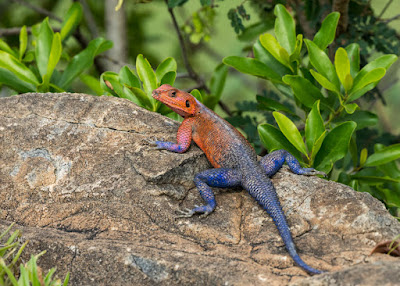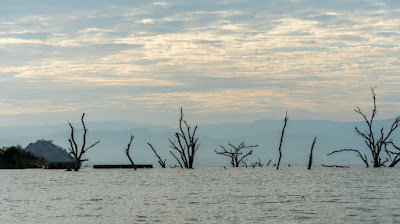 |
| Mariqua Sunbird, Kenya |
With many thanks to our friend Owen Floody, who was my husband's field partner on our trip to East Africa in 1971. Art and I have not been back to Africa since then, but Owen has made numerous trips in recent years and written about several of them for The Intrepid Tourist. His latest report chronicles a trip focused on birds--and much more.
I like birds. I like Africa. So, why not embark on a three-week birding tour of Kenya, especially when fond memories of a past trip strongly endorse the itinerary? Following this reasoning, I found myself spending most of November 2022, on a birding safari organized by Wings Birdwatching Tours and implemented by Ben’s Ecological Safaris, of Nairobi.
 |
| Long-crested Eagle in the Kakamega Forest, Kenya |
Critical to the success of this safari were superb efforts by our guide, Brian Finch, and driver/guide, Ben Mugambi. Both were extremely adept at spotting and hearing birds. And there is not a bird in East Africa that they could see or hear but not identify.
The fact that these efforts were so highly valued reflects, in part, the size, enthusiasm and competence of the audience. At the outset, it surprised me that our group consisted of me and just three others. However, it quickly became apparent that this intimacy was more than a luxury: What would be the value of expert guides if you were stuck in a different vehicle and could not hear them?
Access to the guides might be especially important to participants who already are expert birders and anxious to improve their skills by helping to spot and identify as many birds as possible. With one exception, this perfectly describes the members of this group. As I said, I like birds. But I am not a birder. In contrast, my three companions were dedicated and expert birders with previous birding tours behind them: They knew the drill and were prepared to work hard to expand their life lists.
 |
| Malachite Kingfisher, seen near Lake Victoria |
And this tour did require effort. We typically met for breakfast at 6 am, began birding (on foot or from the vehicle) at 6:30, took a brief lunch break at about 2:30 pm, then resumed birding until returning to our lodge at about 6:30. We then met at 7:30 to review the day’s sightings before moving on to dinner at about 8:30. This routine was taxing but effective, yielding a total of 578 sightings (of different bird species) over the 3 weeks. Many of these were lovely. To illustrate, a few of my favorites are shown in the first three of the associated images, of a Mariqua sunbird, long-crested eagle, and Malachite kingfisher. However, we were not such purists as to ignore animals other than birds.
 |
| Lion |
To the contrary, we reacted as enthusiastically as any visitor to Africa to sightings of lions and were captivated by insects and colorful reptiles such as the Mwanza flat-headed agama shown below.
 |
| Mwanza flat-headed agama lizard |
Though these sightings helped to keep us going, a tiring trip also is eased by scenery that is varied and attractive. In this connection, our itinerary did exactly what I expected of it. We visited many areas in central and western Kenya. These varied on many dimensions and so exposed us to a wide range of habitats and wildlife. We began by flying to the Samburu/Buffalo Springs National Reserve looking for birds of a savannah made more arid than usual by recent droughts. Next, we paid a brief visit to a montane forest on the slopes of Mount Kenya, looking for birds of the forest and clearings. Once back on the road, we headed into and along the Great Rift Valley. Here, we visited two of the famous Rift Valley lakes, Nakuru and Baringo, focusing on birds of the lakes and lakeshores.
 |
| Kakamega Forest |
Next, we spent two days in the Kakamega Forest, an extension into Kenya of the great Congo basin rainforest and one of the few places in East Africa at which rainforest can be found and explored. This made the forest itself a focal point. Nevertheless, we worked hard to see as many forest birds as possible. From Kakamega, we traveled to two areas near Lake Victoria, which forms part of Kenya’s western border. Birds of the lake and adjacent grasslands were the attractions here (including that in 3rd image). Finally, we capped our tour with several days in the Masai Mara National Park, one of the world’s most attractive and productive areas for birds and other animals.
 |
| Zebra in Masai Mara National Park |
Visiting a variety of natural areas in 2022, one could not expect to escape exposure to the consequences of climate change. We did see evidence of such effects, but they were not always as I expected. For example, I visited Samburu in 1991, at which time it stood out as relatively lush. Now, however, it is extremely arid, reflecting the severe droughts that have parched much of Kenya in recent years.
 |
| Flooding in the Rift Valley |
In contrast, the problem facing the Rift Valley lakes is excessive water, which has very significantly increased the levels and areas of these lakes since about 2010. The impacts of these increases are obvious, as drowned stands of trees highlight the increases in lake areas and drowned buildings do the same for the impacts on human life and infrastructure. The causes of these increases are unknown but could include tectonic activity and local agricultural practices as well as climate change.
Finally, a word on birders and birding tours. They go together. In general, I thought that this tour was great: The company was congenial, the itinerary was perfect, and the quality of the guiding was amazing. Still, I think that this trip clearly is aimed at experienced birders (people who self-identify as birders and have been on at least 1 previous birding tour). Non-birders certainly can do it (I did) but should only do so with caution and some prior study of what high-level birding is like.
No comments:
Post a Comment
Note: Only a member of this blog may post a comment.